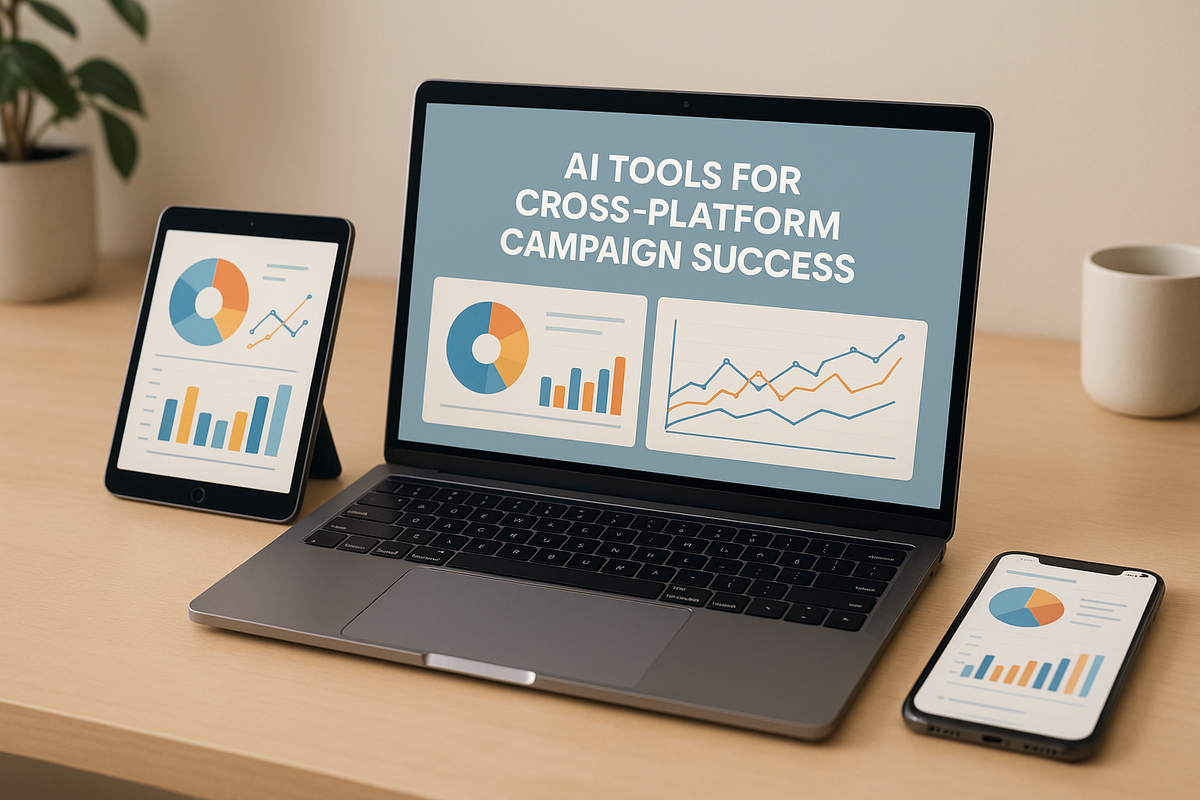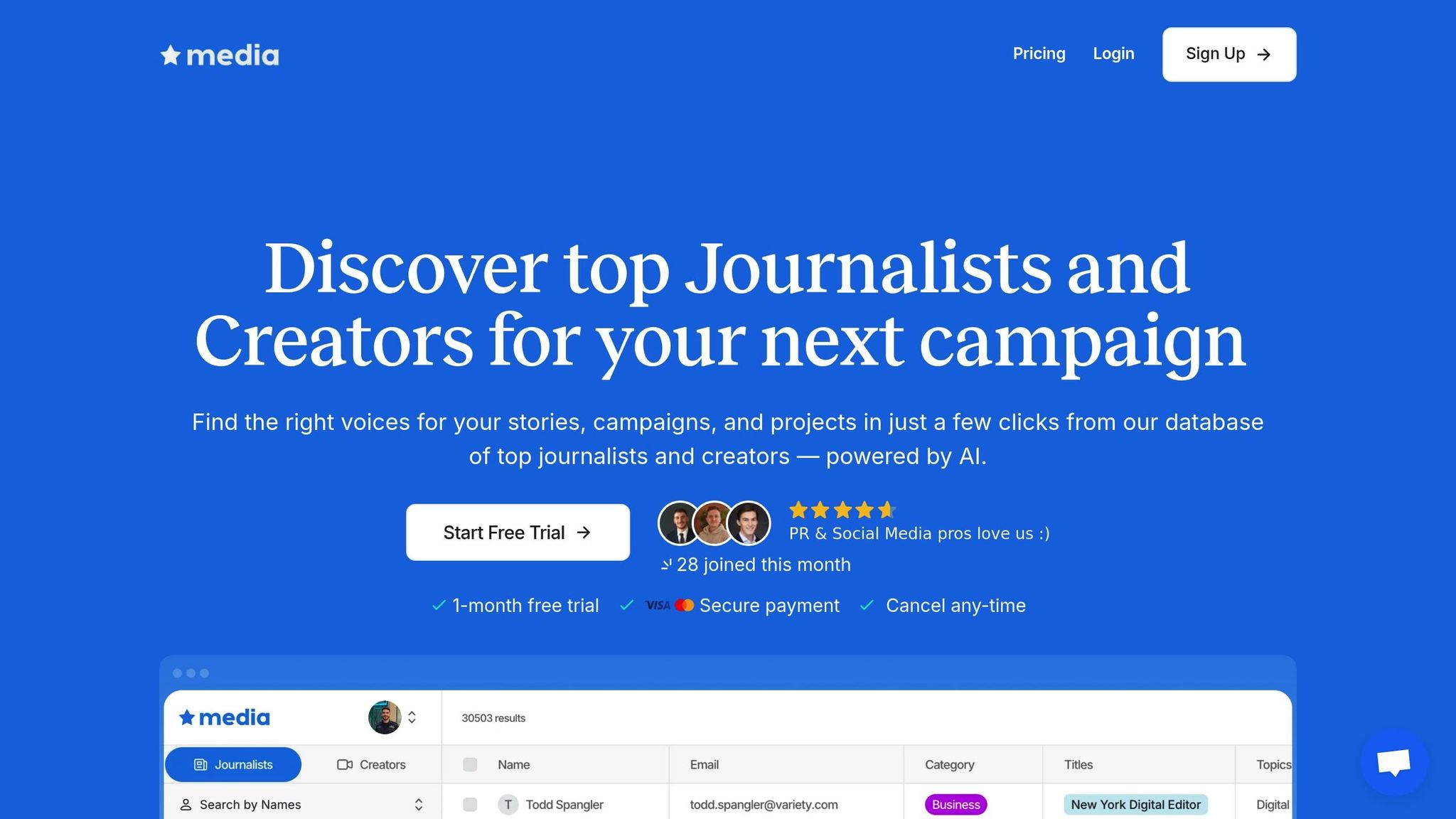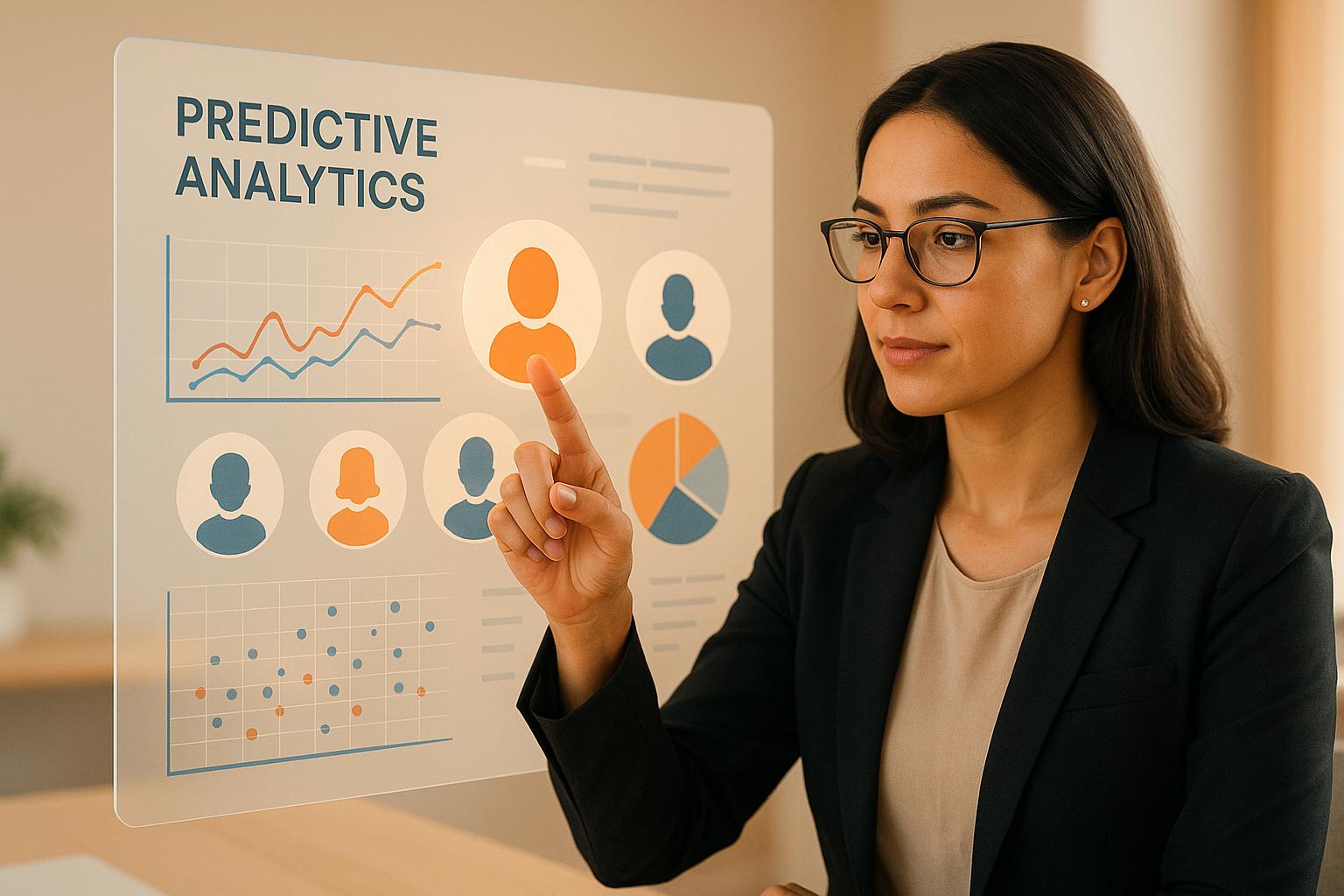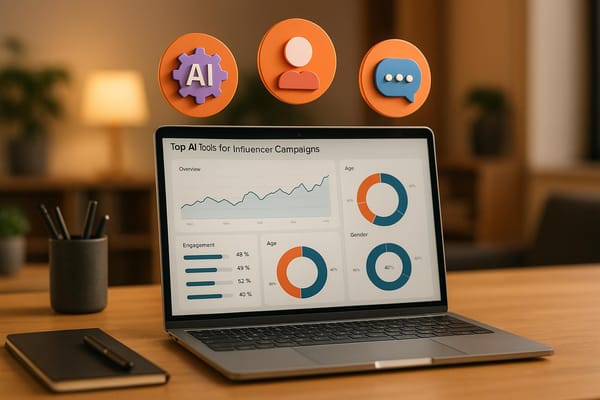AI Tools for Cross-Platform Campaign Success
Explore how AI tools streamline cross-platform campaign management, enhance attribution accuracy, and optimize performance for better results.

Running campaigns across platforms like Facebook, LinkedIn, email, and more can be chaotic without the right tools. AI simplifies this by consolidating data, optimizing workflows, and improving decision-making. Here’s how AI transforms your campaigns:
- Unified Data: AI integrates metrics from multiple platforms into one dashboard, making analysis easier.
- Smarter Attribution: AI tracks customer journeys across channels, ensuring all touchpoints get credit.
- Automated Management: Tools handle repetitive tasks like scheduling posts, reallocating budgets, and updating creative assets.
- Improved Collaboration: Clear workflows and shared dashboards keep teams aligned and efficient.
- PR and Influencer Outreach: AI tools like Media AI streamline finding journalists and creators, saving time.
AI doesn’t just manage campaigns - it enhances their performance by providing insights, automating adjustments, and aligning efforts across channels.
How AI-Native Marketing Platforms Are Transforming Performance Advertising
Setting Clear Goals and Building Team Structure
A strong foundation is the backbone of any successful cross-platform campaign. When teams operate in isolation, chase conflicting metrics, or lack clear task ownership, even the most advanced AI won't salvage the effort. Success begins with proper structure and clearly aligned objectives.
AI enhances what already exists. If your structure is flawed, AI will only amplify those inefficiencies. But with the right framework in place, AI becomes a catalyst that transforms coordinated efforts into standout results.
Defining Shared KPIs Across Platforms
Every platform has its own way of measuring performance. The real challenge isn’t gathering these metrics - it’s aligning them to serve a unified goal.
Start by identifying universal metrics like revenue attribution, customer acquisition cost (CAC), and lifetime value (LTV). These are the benchmarks that matter most. Then, layer in secondary metrics to better understand the customer journey, such as brand awareness, engagement quality, and conversion assist rates.
The trick is to create a metric hierarchy - where platform-specific metrics feed into broader business objectives. For example, LinkedIn might have a lower click-through rate than Facebook, but if LinkedIn delivers higher-quality leads with better conversion rates, that context is critical. AI tools excel at connecting these dots, showing how a LinkedIn impression today might lead to an email conversion next week.
Focus on metrics that directly impact revenue or strategic goals, and let AI track how different touchpoints contribute to these outcomes.
Building a Workflow for Team Collaboration
Cross-platform campaigns often involve multiple teams, each with their own expertise, timelines, and priorities. Without clear workflows, managing these moving parts can feel like herding cats - leaving little time to actually improve campaign performance.
Use tools like a RACI matrix to define roles and responsibilities, ensuring everyone knows their part. Streamline approval processes to balance speed with quality. For routine tasks, such as social media posts or email campaigns, consider pre-approval frameworks where teams can proceed as long as they follow established guidelines. Reserve lengthy approval cycles for high-impact activities like major creative changes or press releases.
Timelines are another key factor. Different platforms operate on different schedules. For instance, PR outreach might require weeks to generate results, while social media can pivot within hours. Account for these differences in your project plans and use AI-powered project management tools to flag potential delays or conflicts automatically.
Communication rhythm also matters. Daily standups might work well for fast-paced social campaigns but could overwhelm PR teams focused on long-term goals. Find the right balance for each team, and use shared dashboards to keep everyone informed without endless meetings.
With clear goals, roles, and workflows in place, your team can fully leverage AI for integrating data across channels.
Using AI for Data Consolidation
A well-structured team allows AI to shine when it comes to organizing and consolidating data. Instead of logging into multiple platforms like Google Ads, Meta Business Manager, LinkedIn Campaign Manager, or email tools, AI can pull all the data into a single dashboard.
The first hurdle AI tackles is data standardization. Different platforms may use varying terms - Google Ads might call it "cost per conversion", while Facebook uses "cost per result" - but they often measure similar things. AI normalizes these metrics, applies consistent attribution models, and presents them in a unified, easy-to-understand format.
The real magic lies in cross-platform correlation. AI can uncover patterns that are hard for humans to spot, like how PR coverage in trade magazines boosts search volume, or how LinkedIn engagement leads to higher email open rates a few days later. These insights allow you to optimize the entire customer journey, not just isolated touchpoints.
With real-time data syncing, you can detect and address issues quickly. For example, if Facebook ads are driving traffic but email conversions are lagging, AI tools will highlight the problem within hours, not days.
When you integrate AI-driven media data with other campaign metrics, you get a unified view of how efforts like media outreach drive engagement and conversions. The goal isn’t just to gather more data - it’s to create a single source of truth that your entire team can rely on. When everyone, from the social media manager to the PR lead and paid ads specialist, is working from the same data with the same context, decisions become faster and more aligned.
Using AI for Cross-Channel Data and Attribution
Once you have a strong team and unified data in place, the next step is tackling the complexity of cross-channel interactions. Customers rarely stick to just one channel before converting, which is where traditional attribution models often fall short. AI steps in to provide a clearer picture of the customer journey, showing exactly how your marketing efforts across channels contribute to results. This insight sets the stage for smarter, AI-driven attribution strategies.
Setting Up Multi-Touch Attribution Models
Many businesses still rely on last-click attribution, which gives all the credit to the final interaction before a conversion. This approach ignores the critical touchpoints earlier in the journey. For example, a customer might first learn about your brand through a PR article, engage with your LinkedIn post, click on a Facebook ad, and finally convert through an email. With last-click attribution, only the email gets credit, leaving the earlier efforts unrecognized.
AI-powered attribution models distribute credit more effectively across all touchpoints. Models like time-decay attribution prioritize interactions closer to the conversion, while position-based attribution highlights both the first and last touchpoints. Then there’s algorithmic attribution, which uses your data to uncover patterns and assign credit in ways that traditional methods might miss.
The best model for your business depends on your goals. If your focus is on brand awareness, you might prioritize top-of-funnel activities like PR and social media. On the other hand, if you’re running direct response campaigns, bottom-funnel touchpoints such as retargeting ads and email campaigns should carry more weight.
Standardizing Campaign Naming and Tracking
For AI to deliver accurate attribution insights, your data collection needs to be consistent across all platforms. Without standardized naming conventions and tracking parameters, even the most advanced AI tools can struggle to connect the dots in your campaigns.
Start by implementing UTM parameters for every campaign. Create a naming convention that includes key details like campaign type, platform, audience segment, and content variation. For instance, "utm_campaign=q3_leadgen_linkedin_cmo_whitepaper" clearly identifies a Q3 LinkedIn campaign targeting CMOs with a whitepaper.
Use clear labels for audience segments to ensure seamless tracking across platforms. Consistency in campaign naming makes it easier for AI to group and analyze performance data.
Offline touchpoints shouldn’t be overlooked either. Events, direct mail, and traditional PR campaigns can be linked to digital attribution models using tools like QR codes, unique landing pages, or promo codes. By aligning offline and online tracking, you can ensure your AI models deliver actionable insights across the board.
Predictive Analytics for Budget Optimization
The real magic of AI attribution lies in its ability to predict future performance and guide your budget decisions. Instead of waiting weeks to analyze campaign results, AI can forecast outcomes and recommend real-time adjustments.
Using historical data, predictive models identify trends and patterns. For example, if AI notices that certain campaigns perform well initially but drop off later, it might suggest allocating more budget upfront or refreshing creative assets mid-campaign.
AI also shines in optimizing budgets across channels. Unlike traditional methods that evaluate platforms individually, AI considers how channels interact. For example, it might recommend increasing your PR budget because earned media coverage boosts the effectiveness of paid ads.
Seasonal forecasting is another area where AI proves its worth. By analyzing years of data, AI can pinpoint the best times for specific channels or audience segments, helping you allocate resources more strategically.
Advanced tools can even simulate different budget scenarios, projecting potential outcomes and identifying optimal spending levels. Instead of pouring more money into high-performing channels without limits, AI can suggest when reallocating funds to other areas may yield better results.
When paired with platforms offering detailed media contact data, AI attribution becomes even more powerful. This combination allows you to track how earned media impacts the performance of all your marketing channels, giving you a unified view of your campaign’s effectiveness.
Automating Campaign Management with AI
Managing campaigns across multiple platforms manually can be a time drain, often creating unnecessary bottlenecks. AI automation steps in to streamline the process, seamlessly aligning paid ads, organic content, and PR efforts while cutting down on repetitive tasks.
Centralized Ad and Content Management
Running campaigns on different platforms usually means juggling multiple dashboards, adjusting budgets one by one, and manually updating creative assets for each channel. AI-powered centralized management tools eliminate this hassle by connecting your advertising accounts and content systems into a single, unified interface.
For instance, you can upload a new creative asset just once, and AI will automatically adapt it for each platform. It even simplifies A/B testing by running tests across multiple channels simultaneously, instead of handling them separately. This way, you can quickly identify which messaging resonates most with your audience, regardless of where they engage with your brand.
If LinkedIn generates strong leads while Facebook underperforms, AI can dynamically reallocate your budget to maximize returns. These automation techniques also work hand-in-hand with AI-driven attribution models, ensuring every channel plays a clear role in meeting your campaign goals. By centralizing your efforts, AI not only simplifies campaign management but also sharpens your social media and PR strategies.
AI-Powered Social Media Planning
Building on centralized management, AI-driven social media planning uses real-time insights to maximize engagement. Social media automation has advanced far beyond simple post scheduling. Today’s AI tools analyze audience behavior, competitor activity, and trending topics to fine-tune both organic and paid campaigns.
AI pinpoints the best times to post based on when your audience is most active. For example, in B2B campaigns, thought leadership pieces might perform best on Tuesday mornings when decision-makers are planning their week, while product updates might see better engagement on Wednesday afternoons.
Another advantage is the coordination between organic and paid efforts. When an organic post starts gaining traction, AI can automatically boost it with paid promotion to expand its reach. On the flip side, if a paid post isn’t delivering results, AI can pause spending and suggest alternative organic content to test new messaging.
Additionally, AI tools adjust hashtags, keywords, and content formats in real time, ensuring your posts fit seamlessly into each platform’s native style and resonate with your audience.
Media AI for PR and Influencer Collaboration

PR and influencer outreach often operate in silos, separate from other marketing efforts. However, they’re essential to the success of cross-platform campaigns. Media AI bridges the gap, offering access to a database of over 30,000 journalists and creators that integrates directly into your campaign management system.
This tool simplifies outreach by filtering media contacts based on criteria like beat, publication type, audience size, and engagement levels. Once filtered, the data can be exported directly into your CRM, making it easier to align PR efforts with your overall campaign strategy.
One of the biggest challenges in PR - outdated contact information - is solved with Media AI’s constantly updated database. The platform also offers flexible pricing, allowing you to scale your outreach as needed. Whether you need access to journalists ($99/month), creators ($99/month), or the full database ($149/month), it’s adaptable to your campaign’s scope.
Media AI shines when coordinating earned and paid media efforts. For example, during a product launch, you can use it to identify journalists covering your industry and align your PR timeline with your paid ad schedule. This ensures that earned media amplifies your paid efforts and vice versa.
Measuring Results and Improving Campaign Performance
With unified data and accurate attribution as the foundation, AI takes the reins to fine-tune campaigns through precise measurement and smart adjustments. While cross-platform campaigns generate massive amounts of data, raw numbers alone don’t lead to success. AI steps in to process this data, turning it into trends, opportunities, and actionable steps.
Weekly Performance Reviews
Once centralized data is in place, monitoring and refining campaign performance becomes the focus. AI-powered analytics tools track key metrics like click-through rates (CTR), cost per acquisition (CPA), and return on ad spend (ROAS) across all channels in real time. These tools consolidate everything into unified dashboards, making it easier to spot patterns that might otherwise go unnoticed.
During weekly reviews, AI algorithms identify underperforming areas. For instance, if one platform shows a higher CPA compared to others, AI may suggest reallocating the budget. In some cases, platforms can even make these changes automatically, shifting resources from channels with lower returns to those performing better.
What’s truly valuable is how AI analyzes performance trends over time. Instead of reacting to daily fluctuations, it highlights sustained patterns. For example, if video ads consistently outperform static images, AI might recommend increasing investment in video content to maximize returns.
AI also excels at cross-channel attribution. When customers interact with multiple touchpoints - like seeing a social media ad, reading an article, and finally converting via search - AI tracks the entire journey. This comprehensive view helps pinpoint which interactions play the most critical roles in driving conversions, ensuring that budget allocations support the most effective channels.
Creative Updates and Audience Expansion
The real magic happens when performance data informs creative decisions and audience targeting. AI identifies subtle trends, such as which headlines or visuals resonate better with specific audiences, and uses this information to suggest improvements for underperforming content.
AI also helps expand your audience. By analyzing the traits of your highest-value customers, it identifies similar audiences across platforms and locates prospects with comparable behaviors and demographics. This opens doors to new opportunities without the guesswork.
Another key advantage is AI’s ability to monitor audience fatigue. If the same creative assets are shown too often, engagement can drop. AI detects this decline and recommends refreshing content or exploring new target segments to maintain campaign momentum.
Additionally, AI predicts new audience segments based on existing customer behavior. This allows you to confidently test new markets with data-driven insights, rather than relying on trial and error. By combining these creative and audience insights with ongoing performance reviews, you can continuously refine your campaigns for better results.
Checking Data Accuracy and Attribution
While AI-driven attribution models offer powerful insights, their accuracy depends on the quality of the data they’re built on. Regular checks are essential to ensure recommendations are based on reliable information, avoiding costly mistakes.
AI tools automatically cross-check data from advertising platforms with CRM or e-commerce system records to flag discrepancies. For example, if an ad platform reports conversions that don’t match CRM data, AI can help trace the issue, whether it’s a broken tracking pixel or a missing UTM parameter.
Attribution models also need to be validated regularly. AI ensures that your models accurately reflect the customer journey, revealing whether certain channels are over- or under-credited for conversions. This enables more informed decisions about where to allocate your budget.
Cross-device tracking adds another layer of complexity, as customers often engage with campaigns on one device and convert on another. AI uses advanced matching techniques to connect these interactions, giving you a more complete view of your campaign’s performance.
Frequent audits are crucial to catching small issues before they snowball. AI monitors for problems like broken tracking pixels or changes in platform APIs that could disrupt data collection. Addressing these promptly ensures your performance data remains consistent and trustworthy.
While achieving perfect attribution is nearly impossible in today’s multi-channel digital world, AI helps you get as close as possible. With reliable measurement, you can confidently optimize campaigns and make smarter budget decisions.
Conclusion: Future of AI in Cross-Platform Campaigns
The way cross-platform campaigns are managed has been reshaped by AI. Tasks that once demanded large teams and endless hours can now be handled through automation. AI simplifies campaign management by bringing together data from various platforms, forecasting trends, and automating adjustments. The result? Smarter, faster, and more effective campaigns.
By pulling data from multiple sources, AI doesn’t just analyze performance - it predicts it. It allocates budgets to the most effective channels and provides a clear picture of the customer journey, helping marketers understand what drives conversions.
The strategies discussed earlier highlight how AI is leveling the playing field. Small teams can now compete with large enterprises, using the same advanced tools that were once reserved for major corporations. A startup with limited resources can achieve campaign results that rival those of Fortune 500 companies, simply by selecting the right AI-driven solutions.
AI also brings new efficiency to PR and influencer marketing. For example, tools like Media AI make it possible to connect with over 30,000 journalists and creators using intelligent filtering and discovery features. This eliminates the need for time-consuming research, allowing teams to focus on building meaningful partnerships and running impactful campaigns.
Looking ahead, AI is set to evolve beyond basic automation. Future developments may include systems capable of predicting market trends, identifying content with viral potential, and adjusting creative elements in real time based on audience reactions. The combination of AI with technologies like augmented reality and voice search will unlock new ways to engage audiences across platforms.
Adopting AI-powered tools now is an investment in long-term success. Teams that embrace these innovations today will be better positioned for the future, while those who hesitate risk falling behind in a marketing world that’s becoming increasingly automated.
FAQs
How does AI enhance cross-channel attribution accuracy in marketing campaigns?
AI enhances the accuracy of cross-channel attribution by processing massive datasets in real time, identifying patterns, and assessing the influence of different touchpoints. By factoring in elements like timing, context, and user behavior, it assigns credit more precisely, minimizing manual errors and offering insights that marketers can act on.
This means businesses can gain a clearer picture of which channels contribute to conversions, fine-tune their campaigns, and make smarter decisions about budget allocation. Many companies report noticeable improvements in ROI within just a few months of adopting AI-powered attribution models.
How can I structure my team to effectively use AI for managing cross-platform campaigns?
To seamlessly bring AI into your campaign management, consider starting with a small pilot team of just 1–2 members. This team can experiment with workflows, identify what works, and tweak processes as needed. Once you’ve nailed down the basics, scale up to an operational team of 3–6 members dedicated to executing and expanding these strategies. As your efforts grow, transition into a larger optimization team with 7–10+ members who can focus on refining strategies and driving innovation.
Make sure to clearly define roles within the team - think data analysts, content strategists, and AI specialists. Encourage collaboration across departments to ensure everyone is aligned. Also, don’t overlook the importance of ongoing training to keep the team sharp and up-to-date with the latest AI tools and methods. By following this phased approach, you can streamline workflows and get the most out of AI to boost your campaign results.
How can AI tools simplify PR and influencer outreach?
AI tools make PR and influencer outreach more efficient by handling tedious tasks like identifying the right journalists and creators, creating tailored pitches, and evaluating campaign performance. These tools simplify the process of finding key contacts, customizing your messaging, and forecasting results, saving time while boosting effectiveness.
Take Media AI, for instance. This tool provides access to a database of over 30,000 journalists and creators, complete with advanced filtering options. It’s a game-changer for PR professionals, social media agencies, and startups, helping them quickly find and connect with the most suitable collaborators. The result? Sharper, more targeted outreach and better campaign outcomes.





